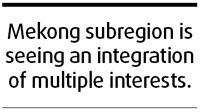Cooperation in Mekong region yields success
By Zhai Kun (China Daily)
Updated: 2008-03-31 07:13
Updated: 2008-03-31 07:13
Premier Wen Jiabao is in Laos attending the third Greater Mekong Subregion (GMS) summit which ends today.
Since the GMS was launched by the Asian Development Bank (ADB) in 1992, the five countries in the region, Laos, Myanmar, Thailand, Cambodia and Vietnam, have all been put on the fast track of growth.

In this process, China has played an active role in enhancing economic regional cooperation. Besides, it has also integrated the cooperation with its domestic strategy of developing Southwest China, which lies in the upper reaches of the Mekong River, called the Lancang River. Thus, a balanced economic development is being nurtured in the greater Mekong area.
The regional cooperation is playing a vital role in promoting comprehensive development of the subregion.
The Mekong River flows through six nations, including China. Its basin covers 2.56 million sq km with a population of 320 million. With vast forests and rich underground resources, the basin boasts one of the best biological reserves in Asia.
The ADB launched the GMS in 1992, aimed at poverty eradication, and all Mekong nations have since been involved in the common initiative of economic development. It was under such a backdrop that the concept of "Greater Mekong Subregion" took shape.
Following the Asian financial crisis of 1997, the Association of Southeast Asian Nations (ASEAN) took the lead in promoting regional cooperation, to which China actively responded by stepping up its cooperation with the Mekong River nations.
Countries in the Mekong subregion today have achieved political peace, social stability, and economic gains.
Regional cooperation within the GMS framework has seen advances in transportation, telecommunications, trade, tourism, and agriculture.
Take transportation as an example. After the Trans-Asian Railway was completed, the key cities in the region, Bangkok, Hanoi, Ho Chi Minh City, Yangon, Phnom Penh, and Vientiane, all started direct flights to their capitals as well as construction of their ports. A transportation network linking water, land and air will play an increasingly important role in the region, and Asia as a whole.
Two criss-crossing corridors have just been completed in the region. The "north-south corridor" - a 2,000-km highway linking Kunming, capital of Yunnan province, and the Thai capital city of Bangkok via Laos, and the "east-west corridor" - a 1,500-km highway stretching from Vietnam's Da Nang through Laos and Thailand to Myanmar, will serve as vital transportation arteries in the region.
The countries in the Mekong River basin have deepened their opening up to each other, nurtured closer ties with the rest of Asia, and the world. Their efforts in recent years are paying off. The per capita annul income was $1,100 in 2006 compared to $630 in 1992.
The development momentum of the region has also attracted the attention of other countries.
The relationship between the United States and the Mekong River nations has improved, especially that between the US and Vietnam. Nguyen Minh Triet, the Vietnamese President, visited the US last year, the first visit by a Vietnamese state head to the US in the 32 years following the end of the Vietnam War.
Japan has also been paying more attention to its diplomatic ties with the Mekong River countries. The current Prime Minister Yasuo Fukuda has designated this year as one of exchange between Japan and nations of the Mekong region. Japan hosted a ministerial meeting in Tokyo with the foreign ministers of the five Mekong region countries in January.
More multinational companies headquartered in the US or Japan are looking to invest in the Mekong region.
It is viewed as the gateway to the east by India. And the link between the Mekong River and the Ganges River is seen as a "natural pivot to advance eastward".
In September last year, Australia published a strategic report on promoting cooperation and integration in the Greater Mekong Subregion, calling the region essential to Australia's interests. The report suggested the Australian government donate A$50 million each year for the next 10 years to countries in the Mekong region.
Many international and non-government organizations have also placed the Mekong subregion higher on their agendas.
It is clear the Mekong subregion is seeing an integration of multiple interests. It would help if more countries reach an understanding about their own roles in aiding the region.
There are several areas in which these countries can help.
The first is biological protection, tapping and protecting water resources. Second, disease prevention, like bird flu, AIDS and encephalitis B.
Other areas include cooperation in fighting terrorism, easing the shortage of manpower, and bridging development disparity in the five countries.
China has developed sound relations with countries of the subregion, an example of China's policy of promoting harmony with its neighbors.
On Friday, the National Development and Reform Commission, the Foreign Ministry and the Ministry of Finance released a report through the People's Daily. In the report, the ministerial departments gave a detailed statement about China's economic and trade ties with the Mekong River countries, its role in promoting regional cooperation, and its plans for participating in regional cooperation in the near future.
The author is director for Southeast Asian and Oceanic Studies, China Institute of Contemporary International Relations.
(China Daily 03/31/2008 page4)
|
|
|
|